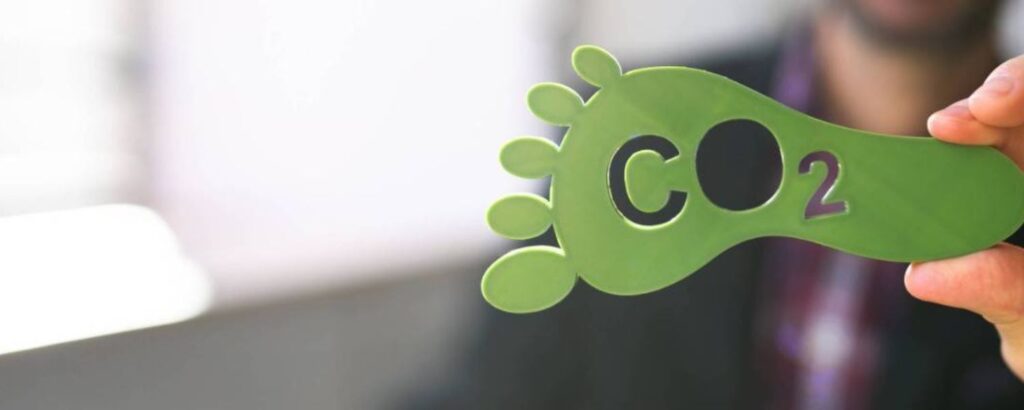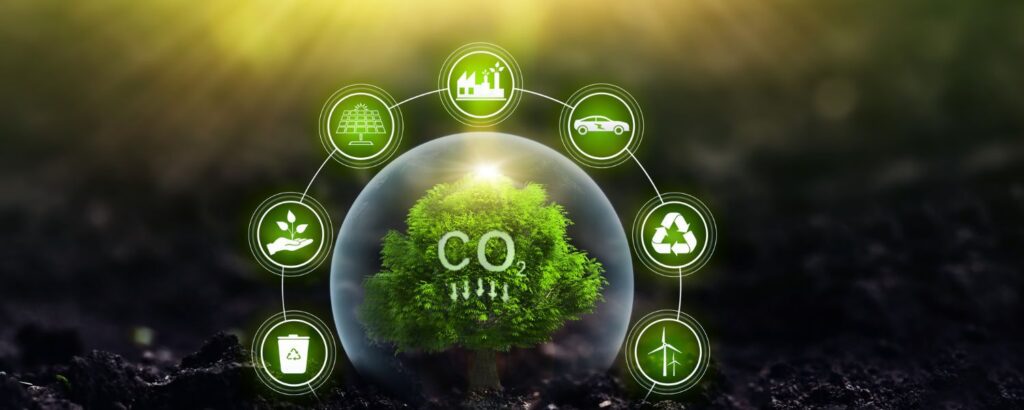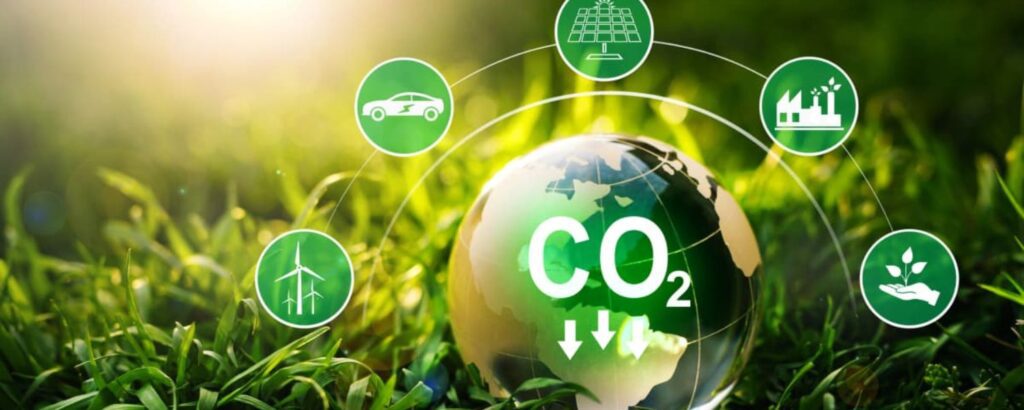Today’s Carbon footprint” has become increasingly important in today”‘s environmentally conscious world. Understanding a carbon footprint, its implications, and how to mitigate it is vital for individuals and businesses. This article delves into the carbon footprint concept, providing insights into its components, significance, and actionable steps to reduce it.
Defining Carbon Footprint

Further, the entire quantity of greenhouse gases, mostly carbon dioxide, emitted into the atmosphere as a result of human activity is referred to as one’s “carbon footprint”. However, these activities range from car driving to manufacturing goods and energy consumed in homes and offices. The carbon footprint is usually measured in metric tons of CO2 equivalent, encompassing not just CO2 but other greenhouse gases such as methane or nitrous oxide, which contribute to global warming.
Components of a Carbon Footprint

A carbon footprint can be divided into several categories:
- A. Direct Emissions: These are directly released by an individual or organization. Examples include the fuel burned in cars and heating systems in homes.
- Indirect Emissions: These arise from producing and transporting goods and services consumed. This includes emissions from the manufacturing of products and the energy required to transport them to consumers.
- Life Cycle Emissions: This broader perspective includes emission monitoring solutions from the entire lifecycle of a product/service, from raw material extraction to disposal.
Why the Carbon Footprint Matters

Understanding and addressing the carbon footprint is crucial for several reasons:
- Climate Change: The accumulation of greenhouse gases in the upper lever of atmosphere leads to global warming and environment change, causing extreme weather events, rising sea levels, and biodiversity loss.
- Health Impacts: Increased air pollution from carbon emissions contributes to respiratory diseases, cardiovascular problems, and other health issues.
- Economic Costs: Climate change leads to substantial economic costs, including damage to infrastructure, increased healthcare expenses, and loss of productivity in various sectors.
Carbon Footprint Examples

Different activities contribute differently to the carbon footprint. Here are some common examples:
- A. Transportation: Cars, airplanes, and ships emit significant amounts of CO2. For instance, a round-trip flight from New York to Los Angeles can generate over one ton of CO2 per passenger.
- B. Energy Consumption: The electricity and heating used in homes and businesses are significant contributors. Additionally, fossil fuels such as coal, oil, and natural gas are primary energy sources, each with a high carbon output.
- C. Agriculture: The agricultural sector emits greenhouse gases through livestock digestion, fertilizer use, and rice production. Two significant contributions are nitrous oxide from fertilizers and methane from cattle.
- D. Waste Management: As organic waste decomposes, methane, a greenhouse gas is more powerful than CO2, is produced in landfills.
Ways to Reduce Carbon Footprint

Reducing your carbon footprint involves making conscious choices to lower greenhouse gas emissions. Here are some effective strategies:
- Energy Efficiency: Improve the energy efficiency of your home and workplace. This can include using energy-efficient appliances, LED lighting, and better insulation.
- Renewable Energy: Transition to renewable energy sources such as solar, wind, or hydroelectric power. Installing solar panels or opting for green energy plans can significantly reduce carbon emissions.
- Transportation Choices: Opt for public transportation, carpooling, biking, or walking instead of driving alone. For long distances, choose trains over planes when possible.
- Dietary Changes: Reducing meat consumption, particularly beef and lamb, can lower your carbon footprint. Plant-based diets are less carbon-intensive.
- Waste Reduction: Reduce, reuse, and recycle to minimize waste. Composting organic waste and avoiding single-use plastics are excellent steps.
- Sustainable Products: Choose products with minimal packaging, made from recycled materials, or those certified as sustainable. Supporting companies with sustainable practices also encourages broader industry changes.
Carbon Footprint Reduction

Several organizations and communities have successfully reduced their carbon footprints through innovative approaches:
- Corporate Initiatives: Companies like Apple and Google have committed to carbon neutrality by investing in renewable energy and improving efficiency.
- City Programs: Cities like Copenhagen aim to become carbon neutral by implementing green transportation systems, sustainable urban planning, and renewable energy projects.
- Individual Actions: People around the world are adopting sustainable lifestyles by using electric vehicles, installing home solar systems, and practicing minimalism to reduce consumption.
Challenges in Reducing Carbon Footprint

Despite the growing awareness and efforts, several challenges impede carbon footprint reduction:
- Economic Barriers: The initial cost of renewable energy installations and energy-efficient technologies can be high, deterring widespread adoption.
- Behavioral Changes: Changing long-standing habits and lifestyles requires significant effort and commitment. Public education and incentives are crucial in driving these changes.
- Policy and Regulation: Effective policies and regulations are essential for large-scale impact. However, political and economic interests often delay or weaken climate action initiatives.
Technological Innovations for Carbon Footprint Reduction
Technological advancements offer promising sustainable solutions for reducing carbon footprints:
- Carbon Capture and Storage (CCS): This technology captures CO2 emissions from industrial sources and stores them underground, blocking their entry into the atmosphere.
- Electric Vehicles (EVs): EVs produce no tailpipe emissions and, when charged with renewable energy, significantly lower transportation’s carbon footprint.
- Smart Grids: These allow for efficient electricity distribution and use, integrate renewable energy sources, and reduce wastage.
The Role of Governments and Organizations
However, governments and organizations play a pivotal role in addressing the carbon footprint:
- Policy Development: Governments must enact robust climate policies, including carbon pricing, emissions regulations, and incentives for renewable energy adoption.
- Corporate Responsibility: Businesses should adopt sustainable practices, like reducing waste and energy consumption and investing in green technologies.
- International Cooperation: Global challenges like climate change require international collaboration. Agreements like the Paris Agreement are crucial for coordinated efforts.
How Individuals Can Make a Difference
Mainly, individual actions, when multiplied across millions of people, can create a significant impact:
- Educate and Advocate: Raise awareness about the importance of lowering the carbon footprints and advocate for sustainable policies and practices.
- Personal Choices: Make eco-friendly choices in daily life, such as conserving energy, reducing waste, and supporting sustainable businesses.
- Community Involvement: Join or support local environmental groups and initiatives to reduce the community footprint.
The Future of Carbon Footprint Management
Looking ahead, several trends and innovations are expected to shape the future of carbon footprint management:
- Increased Use of AI: Artificial intelligence can optimize energy use, predict emissions, and enhance the efficiency of renewable energy systems.
- Decentralized Energy Systems: Microgrids and decentralized energy production allow communities to generate and manage their energy, reducing reliance on fossil fuels.
- Circular Economy: Shifting towards a circular economy, where resources are reused or recycled, minimizes waste and reduces carbon emissions.
Behavioral and Lifestyle Changes
The individual lifestyle choices people make daily significantly impact the overall carbon footprint. Here are some specific behavioral changes that can contribute to reducing emissions:
- Conscious Consumption: Being mindful of what we buy, how much we consume, and the origins of our products can reduce demand for high-carbon goods. Opt for locally produced items to cut down on transportation emissions.
- Efficient Water Use: Conserving water saves this precious resource and lowers the energy required for water heating and treatment. Simple actions like fixing leaks and using water-efficient fixtures make a difference.
- Minimalism and Decluttering: Adopting a minimalist lifestyle reduces consumption and waste. Fewer possessions mean less production demand, which in turn lowers carbon emissions.
- Supporting Sustainable Brands: Supporting brands prioritizing sustainability and ethical production practices can drive industry-wide changes. Look for certifications like Fair Trade, Organic, and Cruelty-Free labels.
Educational Initiatives and Outreach
Education is a powerful tool in the fight against climate change. Spreading awareness and knowledge about the carbon footprint can inspire collective action:
- School Programs: Integrating environmental education into school curricula helps young people understand the importance of sustainability from an early age.
- Community Workshops: Local governments and organizations can host workshops to educate the public on practical ways to reduce carbon footprints.
- Online Campaigns: Leveraging social media and online platforms to spread information about climate change and carbon footprint reduction can reach a global audience.
- Collaboration with Influencers: Partnering with influencers and public figures to promote sustainable technology solutions practices can amplify the message and encourage followers to adopt similar behaviors.
Economic Incentives for Carbon Footprint Reduction
Further, financial incentives can play a crucial role in encouraging individuals and businesses to adopt greener practices:
- Tax Rebates: Governments can offer tax rebates for energy-efficient home improvements, electric vehicle purchases, and renewable energy installations.
- Subsidies: Providing subsidies for renewable energy projects, public transportation, and sustainable agriculture can make these options more accessible.
- Carbon Credits: Implementing carbon credit systems where businesses can trade emissions allowances encourages companies to invest in cleaner technologies.
- Green Loans: Financial institutions can offer favorable loan terms for projects that reduce carbon emissions, such as home solar panel installations or energy-efficient building retrofits.
Global Efforts and Agreements
However, international cooperation is essential to address the global issue of climate change effectively. Important agreements and initiatives include:
- The Paris Agreement: The goal of this historic accord is to keep global warming well below 2 degrees Celsius, with efforts to keep it to 1.5 degrees. It involves commitments from countries to reduce their greenhouse gas emissions.
- United Nations Framework Convention on Climate Change: However the UNFCCC is an international environmental treaty to combat climate change by averaging greenhouse gas concentrations.
- The Kyoto Protocol: An international agreement that requires its signatories to cut back on greenhouse gas emissions, predicated on the idea that CO2 emissions from human activity are the first cause of global warming.
- Global Climate Strikes: Movements like Fridays for Future, led by young activists, have raised global awareness and pressured governments to act on climate change.
Corporate Sustainability Practices
However, businesses play a critical role in reducing the global carbon footprint. Additionally, adopting sustainable practices not only helps the environment but can also improve a ccompany’s bottom line:
- Sustainable Supply Chains: Companies can audit their supply chains to ensure they sustainably source materials and minimize emissions throughout production.
- Green Building Practices: Implementing green building standards, such as LEED certification, can significantly reduce a building footprint through energy efficiency, sustainable materials, and waste reduction.
- Employee Engagement: Encouraging and facilitating sustainable practices among employees, such as telecommuting, carpooling, and waste reduction initiatives, can collectively reduce the corporate carbon footprint.
- Transparent Reporting: Regularly reporting on sustainability metrics and carbon emissions creates accountability and demonstrates a commitment to environmental responsibility.
The Role of Technology in Reducing Carbon Footprint
Technology offers innovative solutions to many of the challenges associated with reducing the carbon footprint:
- Renewable Energy Technologies: Advances in solar, wind, and other renewable energy technologies continue to make these sources more efficient and affordable.
- Smart Home Devices: Smart thermostats, energy-efficient appliances, and home automation systems help reduce energy consumption.
- Electric and Autonomous Vehicles: The development of electric and autonomous vehicles promises to lower emissions from transportation, one of the biggest causes of carbon footprints.
- Blockchain for Transparency: Blockchain technology can provide transparency in supply chains, ensuring that products are sustainably sourced and produced.
Agriculture and Carbon Footprint
However, agriculture is a significant contributor to greenhouse gas emissions, but it also holds potential for carbon footprint reduction through sustainable practices:
- Regenerative Agriculture: Cover cropping, crop rotation, and no-till farming enhance soil health, sequester carbon, and reduce emissions.
- Precision Farming: Using technology to optimize planting, fertilization, and irrigation can increase efficiency and reduce waste.
- Reducing Food Waste: A significant amount of food produced is wasted, contributing to unnecessary emissions. Better food management and distribution can mitigate this issue.
- Plant-Based Diets: Encouraging plant-based diets can reduce the demand for high-emission livestock products.
The Impact of Urbanization
Urbanization has a significant impact on carbon footprints, but cities also offer opportunities for large-scale carbon footprint reduction:
- Green Urban Planning: Designing cities with green spaces, efficient public transportation, and sustainable building practices can reduce urban carbon footprints.
- Public Transportation: Investing in efficient, reliable, and green public transportation systems can significantly reduce emissions from personal vehicles.
- Smart Cities: Leveraging technology to manage resources efficiently, monitor pollution, and optimize energy use can create more sustainable urban environments.
- Green Roofs and Walls: Integrating green roofs and walls in urban design can improve insulation, reduce energy use, and enhance air quality.
Financial and Market Mechanisms
Markets and financial mechanisms can drive the reduction of carbon footprints through innovation and investment:
- Carbon Markets: Carbon taxes and cap-and-trade programs give companies financial incentives to cut emissions.
- Green Bonds: These financial instruments provide funding for initiatives that enhance efficiency or use renewable energy sources and have a positive impact on the environment.
- Sustainable Investing: Investors increasingly seek out companies with strong environmental practices, driving more businesses to adopt sustainable operations.
- Divestment Movements: Encouraging divestment from fossil fuels and investing in renewable energy can shift capital towards sustainable industries.
Innovations in Energy Storage
Energy storage technology is crucial for maximizing the potential of renewable energy:
- Battery Technology: Advances in battery technology, including lithium-ion and emerging alternatives, make renewable energy more reliable and practical.
- Grid Storage: Large-scale energy storage solutions enable the balancing of supply and demand, integrating more renewable energy into the grid.
- Decentralized Storage: Home and community-level energy storage systems can provide resilience and reduce reliance on centralized power plants.
- Vehicle-to-Grid (V2G): Electric vehicles can be energy storage units, returning power to the grid during peak demand.
Conclusion
The journey to understanding and reducing the carbon footprint is essential for a sustainable future. By making conscious choices and advocating for broader changes, individuals, businesses, and governments can collectively mitigate the impacts of climate change. As awareness and technology advance, with the support of organizations like VectorGlobe, achieving significant carbon footprint reduction becomes more feasible, paving the way for a healthier planet for future generations. VectorGlobe’s commitment to sustainability plays a crucial role in this global effort.

